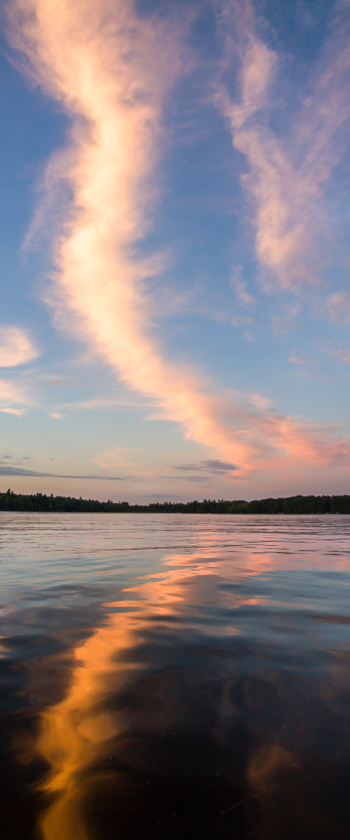 When I photograph a sunset I don’t usually plan to turn my back to the sun and orient my camera vertically. Sometimes, however, you just have to go with the flow.
When I photograph a sunset I don’t usually plan to turn my back to the sun and orient my camera vertically. Sometimes, however, you just have to go with the flow.
Earlier in the week I was in Three Lakes, Wisconsin. The weather was warm and sunny, and beautiful white clouds decorated the blue sky. As the day began to wane it looked like it might be one of those evenings where we would be rewarded with a nice sunset. I didn’t look to the west, however, because I couldn’t resist watching a cloud in the east as it began to soak up the warm, late-afternoon glow of the sun.
According to The Photographer’s Ephemeris, the sunset that evening in Three Lakes would be oriented at 286 degrees. I was on a pier facing in a direction of about 60 degrees. As the sun continued to set the cloud continued to get more orange and its reflection in the lake became more intense.
I started out taking horizontal pictures with the reflection in the lake taking up about two-thirds of the frame. Then I switched to vertical and tried to get as much of the cloud and its reflection in the same frame. In this orientation, despite having my 17-85 mm lens set to 17 mm, I could not capture enough of the scene. A full-frame camera might have captured it all but my APS-C sensor converts a 17 mm lens to about 27 mm. That wasn’t wide enough for what I wanted.
Finally, I decided to keep the camera oriented vertically and take two pictures that I could use to create a panorama. This would allow me to include the majority of the cloud and its reflection. I took one photo that was mostly sky with some lake and the other mostly lake with some sky. For the second picture I laid down on the pier in order to get close to the water.
Because of the sharp line of the horizon, I didn’t bother to use Photoshop’s panorama function to create the final image. I simply put the images in separate layers, lined up the horizons, masked out the overlapping parts and merged them into the final photograph — a vertical panorama taken at sunset.